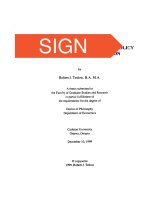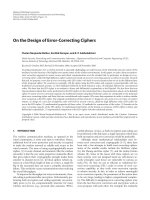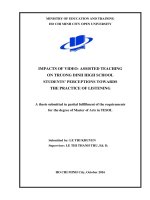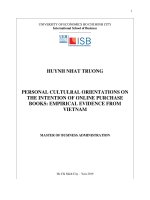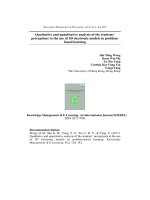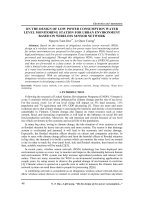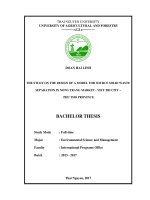Investigating English-majored students’ perceptions on the design of online courses
Bạn đang xem bản rút gọn của tài liệu. Xem và tải ngay bản đầy đủ của tài liệu tại đây (538.32 KB, 14 trang )
Tạp chí Khoa học Ngơn ngữ và Văn hóa
ISSN 2525-2674
Tập 6, Số 1, 2022
INVESTIGATING ENGLISH-MAJORED STUDENTS’
PERCEPTIONS ON THE DESIGN OF ONLINE COURSES
Pham Thi Kim Anh*
Ho Chi Minh City University of Technology and Education
Received: 20/07/2021; Revised: 20/12/2021; Accepted: 29/04/2022
Abstract: The study aims to examine EFL students’ perceptions on the effectiveness of
online course design. This paper employs a mixed-method research design using both
quantitative and qualitative approaches. More specifically, a questionnaire for 83 Englishmajors and a follow-up interview for 10 students were undertaken at HCMC University of
Technology and Education. The data were then analyzed using the SPSS 20.0 software to
calculate mean scores of the surveyed items. The findings disclosed that some online course
features such as course structure, assessment and technology tools were found to be efficient
and most students had positive attitudes towards teachers’ online course design. Moreover,
some shortcomings of the course plan were identified. The study also points out some
practical suggestions from the students’ viewpoints which can be used to guide online course
design for instructors to improve the online teaching quality in the future.
Key words: Perceptions, online course design, online education
1. Introduction
The Covid-19 pandemic has forced all educational institutions to be closed and shift into
online instruction for the continuity of learning. The sudden transformation into a new virtual
environment has caused numerous obstacles for teachers in preparing and developing fullyfeatured online instruction. Most educators have mainly transferred the educational contents into
web-based education, rather than based on the ordinary course design. This raises a consideration
of online course design as the prerequisite for implementing online teaching for the purpose of
promoting teaching effectiveness in a virtual setting. A well-planned course design can stimulate
learner engagement (Farrell & Brunton, 2020; Dahalan et al., 2013) and facilitate students to
navigate as well as associate the course concepts together to have an overview of the whole course
(Reushle et al., 1999). Therefore, this study is designed to examine how students perceive the
effectiveness of the online course design. Based on the investigation of students’ perception, the
recommendations can be made for the improvement of the future course design.
Even though a multitude of publications have examined various dimensions of online
education in the Covid-19 crisis period, including course design (e.g., the design and development
process of online courses (Baldwin et al., 2018), its critical elements and issues (Bruster, 2015;
Wang, 2000; Diorny, 2012), teachers’ lived experiences and practices (Lenert & Janes, 2017;
Peruski & Mishra, 2004; Colak, 2018), student satisfaction (Placencia & Muljana, 2019), and
online learners’ perspectives towards course design in statistics class (Yang, 2017)), few data
have been collected to specify learner opinions on online course design in the current literature in
general and particularly in the context of Vietnam. Accordingly, to fill this gap, the present study
aims to examine what EFL students perceive about the online course design concerning its
*
Email:
1
Journal of Inquiry into Languages and Cultures
ISSN 2525-2674
Vol 6, No 1, 2022
appropriateness and shortcomings of the design features so that instructors can adjust the design
of their online courses to boost the efficacy of online education.
The online course design is closely associated with learner engagement in online learning
and the implementation of online teaching. It is very crucial for educators to fully comprehend
the positive and negative dimensions of the design features, especially from students’ viewpoints,
from which certain solutions can be obtained to enhance teaching efficiency. Thus, this study is
expected to provide online instructors with suggestions and guidelines to reach high-quality
design of internet-based teaching. Additionally, litle empirical research has been done in the
perspectives towards online course design at tertiary level so far, so the results of this study are
supposed to provide more evidence to the current literature related to e-learning.
2. Theoretical framework
2.1. Definition
Course design is considered as the process and method of creating quality learning
environments and experience for students, focusing on intellectual development with the
assistance of technology (McGee & Reis, 2012). An online course design should stimulate
students’ active learning and collaboration among learners, support students to make connections
between the course concepts and the other ideas, express teacher social presence on a daily basis,
with appropriate technology tools to support diverse learning activities (Chickering & Gameson,
1987). In other words, an effective online course design should stimulate the interaction with
regular social presence. It should be a fertile environment for students to develop their critical
thinking skills and personalized learning at their own pace. The teaching and learning activities
should be process-driven wherein the final product is as important as their learning procedure.
2.2. Critical elements of online course design
Based on Lister’s literature review (2014) and other related research about the core
components of online course design, the present paper synthesizes the three major elements of
designing a virtual classroom, namely course structure, interaction and assessment/testing. With
the purpose of investigating learners’ perceptions on online course design, this course design
framework of three major dimensions is chosen for this study.
Course structure
Course structure refers to the shape of an online course on the virtual platform, including
course guidelines and expectations (learning objectives, learning outcomes, class regulations,
teaching/learning methods, grading and testing, samples of completed assignments or deadline
reminder), learning material presentation (references, coursebooks, and other related materials). The
course outline should be clear and consistent for students to grasp what they are learning throughout
the course and follow the course rhythm straightforwardly. A better use of time to navigate around
the course information helps students focus on and prepare for learning better.
Interaction
There are four types of interaction in web-based classrooms, specifically the interaction
between students with their peers, teachers, learning content and technology (Nguyen, 2017).
2
Tạp chí Khoa học Ngơn ngữ và Văn hóa
ISSN 2525-2674
Tập 6, Số 1, 2022
Student-student interaction has the greatest impact on students’ learning achievement
(Nguyen, 2017). It should be frequent, active and collaborative which inspires students to interact
with each other socially and academically through team/pair activities, discussion forums,
comment posts or question-answer space, etc. An efficient design of peer interaction creates a
sense of belongings, satisfying their personal and course needs.
Teacher-student interaction can be practiced in synchronous and asynchronous
classrooms. Teachers can interact with learners by partaking in discussion forums, replying to
comment posts, supplying well-timed facilitation or celebrating e-conferencing (Gultom &
Suhartini, 2020). Especially, timely and prompt feedback to student products is crucial to motivate
students to join the online interaction; teacher feedback should also be constructive and detailed
for students to understand and improve their learning performance (Xu et al., 2021; Richardson
et al., 2016). Teacher presence is vital to establish a safely virtual environment and hence engage
learners in the learning process.
Student-content interaction refers to the contact with a wide variety of learning activities
and materials, e.g., PowerPoint presentation, video recordings, tutorial videos or quizzes and
exercises. Different teaching activities stimulate learners’ interests and needs as well as meet their
different learning styles since students have various choices (Ausburn, 2004). Various and
rigorous course content can stimulate learners’ active learning and critical thinking skills. For
instance, assignments with constant reflection on readings, mutual comments or discussion help
students relate the course materials to their personal lives and give them opportunities to express
their own opinions, which boosts their critical thinking skills (Teräs & Herrington, 2014). The
learning tasks need to be authentic and purposeful, especially connected to real life situations
(Gedik et al., 2013). In this way, students can see the relevance of the course content with the real
world as they can link their learning with hands-on experience, from which their curiosity is
boosted and then they feel more motivated.
Student-technology interaction is mainly through the LMS system and learning platforms.
The LMS platform supports students to access the learning materials, quizzes, assignments, forums,
interaction, or review the recordings for later revision. Online teachers should select user-friendly
digital tools since students are not always competent at technology (Lee, 2014). The difficult access
to the technology tools makes them confused and uncomfortable, intervening their engagement and
negatively impacting their learning motivation.
Assessment and testing design
Boitshwarelo et. al. (2017) present principles for the design of online tests with six
components, including purpose, context, learning outcomes, tasks, feedback processes, and
interaction. For an effective online test design, the test purpose is clearly clarified to students,
both recalls foundational knowledge and develops cognitive knowledge as well. The diverse
assessment tasks with transparent marking schemes and instructions are contextually relevant and
aligned with the course learning outcomes (Yonker, 2011) and should be used frequently at
different stages throughout the course to enhance student engagement and performance (Smith,
2007). Additionally, these tasks should be authentic (Montgomery, 2002), contributing to
students’ real-life experience, developing problem-solving skills, and stimulating peer/self3
Journal of Inquiry into Languages and Cultures
ISSN 2525-2674
Vol 6, No 1, 2022
assessment to promote their self-regulation (Gardner-Medwin, 2006). The immediate feedback
with reference to relevant resources can also reinforce student learning (Kibble, 2007).
This section summarizes the key factors of online course design with clear and consistent
course structure for students to navigate around and follow the course information easily, with
frequent and efficient online interaction in both academic and social aspects, combined with
purposeful and relevant e-assessment design, especially boosting student cognitive knowledge
and the peer collaboration with timely feedback.
2.3. Previous studies related to students’ perception towards online course features
Research on online course design from students’ perspectives in EFL context is still
limited in number, but there are still some notable attempts.
Lee (2014) investigated students’ satisfaction levels with online course structure on 81
mathematics graduates by using a 24-item questionnaire. The findings indicated that over 80% of
the participants agreed that clear guidelines for course assignments were vital for learners to
clarify the final products and better perform their tasks. The course organization included a
deadline checklist presented at the beginning of the course and the accessible online materials.
Regarding teacher presence, the participants expected instructor’s open communication with
quick response to students through email, constructive and pertinent feedback on their works.
Concerning technical dimension, nearly 80% agreed that the technology tools should be simple
and easy to access as not all students are competent at using technology. They also wished
instructors to provide adequate training on technical aspects to reduce frustration.
Farrell and Brunton (2020) carried out a qualitative study to explore the factors
influencing student engagement experiences in online classes among 24 online learners at Dublin
City University. The research found that peer interaction was perceived as an essential source of
encouragement and human connection. Also, an engaging online teacher who provides module
support in synchronous online sessions and in asynchronous discussion forums has a significant
impact on learners’ success and engagement.
Fontanillas et al. (2016) carried out quantitative research to explore student perceptions
on the e-assessment and their roles during this process on 913 students. Students were assessed
by using project-based learning including the continuous process assessment and the final
outcomes. The findings showed that most students had high satisfaction with the course’s
evaluation model. The constant assessment made them work harder, especially the assessment
criteria were fully explained to students which helped them understand the assessment tasks and
teacher expectations, and the involvement in peer and self-assessment gave students a critical
perspective of their own and other groups’ products. Particularly, students highly valued teacher’s
thorough feedback and relevant interaction to groupwork which promoted group dynamics.
Rostaminezha (2019) investigated 40 students’ perceptions about instant feedback on etests from the University of Birjand in Iran by using a pilot study. The findings indicated that
instant feedback provided a self-assessment opportunity for students but also had a negative
impact on their performance since they were always concerned about their results during the test.
4
Tạp chí Khoa học Ngơn ngữ và Văn hóa
ISSN 2525-2674
Tập 6, Số 1, 2022
The paper suggests that teachers should notice the personalization of electronic tests based on
learner preference of feedback type to decline their exam anxiety.
The studies cited above have focused on learners’ perceptions on different aspects of
online course design in various learning settings. From the above research results, it is currently
raising the concern to the author whether or not these reported findings could be reasonably and
comprehensively applied to the case of EFL students at UTE. This concern has motivated the
present study.
3. Methods
3.1. Research design
This study employed mixed-method research design. The combination of both
quantitative and qualitative is to confirm the interpretation of the research findings as well as
ensure the generalization of the data in a diverse perspective (Creswell, 2014).
3.2. Research questions
The current article attempts to search for the answers to the following research question:
What are EFL students’ perceptions on the online course design?
This question leads to the three sub-questions:
1. How do EFL students perceive the design of online course structure?
2. How do EFL students perceive the design of online interaction?
3. How do EFL students perceive the design of online assessment and testing?
To expand the quantitative data, interview questions will be used as follows:
What features of online course design are effective?
What design features of online courses do EFL students find essential to be improved?
What suggestions do EFL students have to improve the online course design
3.3. Setting of the research and participants
The research was conducted at the Faculty of Foreign Languages, Ho Chi Minh City
University of Technology and Education where different online courses have been implemented
so far. Since last years’ Covid-19 outbreak, all students of multiple disciplines mainly took
synchronous and asynchronous classes and did the final exams online. 83 EFL students who
already had experiences of online learning for at least two semesters were chosen to provide their
thoughts and perceptions on online course design. Participants were sophomores, juniors and
seniors attending 13-15 online courses on average (62% females, 38% males).
5
Journal of Inquiry into Languages and Cultures
ISSN 2525-2674
Vol 6, No 1, 2022
3.4. Data collection
The quantitative data were collected via an online questionnaire applying Google survey.
After the survey, 10 participants agreed to individually partake in the semi-structured interview
through “Google meet”. The author informed the participants on issues such as informed consent,
anonymity, the storage of confidentiality and compensation. They were aware that the interview
was recorded. The interview was totally administered in Vietnamese to ensure convenience and
absolute comprehension. After being clearly informed and explained the theme and purpose of
the study, the participants were asked to respond to a number of questions related to the topic.
Each interview lasted approximately 15 minutes and proceeded until the participants had no
further information to share.
3.5. Data instrument
The instrument used is a 5-point Likert scale questionnaire consisting of 21 question items
based on a 3-dimensional online course design framework as presented above. The first 6 items
were used to explore learners’ opinions on online course structure, the next 10 items on online
interaction, and the last 5 items on online assessment/testing.
The semi-structured interviews with open-ended questions were used to require students to
share their thoughts on the online course design concerning its shortcomings, its effectiveness and
some suggestions for improvement. Deep interview was used as the main data collection tool since
it can provide the researchers an opportunity to provide deeper understanding of learners that cannot
be obtained through the results from questionnaire (Creswell & Creswell, 2018).
3.6. Data analysis
For quantitative data, the SPSS program 20.0 was employed for data analysis. The items
of the participants’ perceptions using a 5-point Likert scale (with score 1 = Strongly Disagree to
score 5 = Strongly Agree) were quantitatively measured in the unit of mean (M) and standard
deviation (SD).
For qualitative analysis, the content analysis is applied as it “offers an accessible and
theoretically flexible approach to analyzing qualitative data” (Braun & Clarke, 2006). Every
participant was coded, e.g., student No. 1, No. 2, No. 3 was coded S1, S2, S3, etc. The information
from the interview was transcribed. The transcription was then coded and grouped into main
themes and patterns. Then, these themes were interpreted to show any relationships.
3.7. Validity and reliability
The writer checked validity by asking for help from her colleagues while reliability was
tested by using Cronbach’s Alpha.
6
Tạp chí Khoa học Ngơn ngữ và Văn hóa
ISSN 2525-2674
Tập 6, Số 1, 2022
Table 1. Reliability of the main themes in the questionnaire
Online course structure
N of
Cronback’s
items
Alpha
6.886
Average Cronbach Alpha:
Online interaction
N of
Cronback’s
items
Alpha
10.919
.953
Online assessment
N of
Cronback’s
items
Alpha
5.828
The alpha values of each main theme and the whole items are between 0.8 and nearly 1,
the value required for satisfactory reliability. The writer, therefore, concluded that the
questionnaire was reliable for data collection.
4. Findings
4.1. Perceptions towards the design of course structure
Table 2. Survey items regarding perceptions towards online course structure
Items Contents surveyed
I find the guidelines for course
information
and
course
1.1
expectations are informative
and clearly stated.
1.2
1.3
1.4
1.5
1.6
SD
D
N
A
SA
Mean
SD
1
1.2%
2
2.4%
14
16.9%
46
55.4%
20
24.1%
3.99
.789
12
14.5%
35
42.2%
31
37.3%
4
4.8%
I find the presentation of
assessment information clear.
1
1.2%
4.10
The learning materials are wellorganized.
I can understand what I am
going to learn throughout the
course.
I can follow the course rhythms
easily.
I can prepare for the course
better.
1
1.2%
4
4.8%
15
18.1%
42
50.1%
21
25.3%
3.94
.860
1
1.2%
7
8.4%
23
27.7%
37
44.6%
15
18.1%
3.70
.907
1
1.2%
3
3.6%
8
9.6%
9
10.8%
24
28.9%
20
24.1%
34
41%
35
42.2%
16
19.3%
16
19.3%
3.67
.938
3.63
1.033
.905
Table 2 shows the result of students’ perceptions on online course structure. Overall, the
participants agreed on the appropriateness of the online course outline. The highest mean score is
on the presentation of online assignment and testing information (item 1.2: M = 4.10, SD = .905),
followed by course information and expectations (item 1.1: M = 3.99, SD = .789) and then the
learning material presentation (item 1.3: M = 3.94, SD = .860). It was also reported that the clear
design of online course helped learners have an overview of the course (item 1.4: M = 3.70, SD
= .907), follow the course straightforwardly (item 1.5: M = 3.67, SD = .938), and prepare for the
course better (item 1.6: M = 3.63, SD = 1.033).
The data from the interview also indicated that all interviewees found the guideline
information was consistently presented. They especially valued the updated lectures and wellorganized learning materials, from which they could find the essential information easily.
7
Journal of Inquiry into Languages and Cultures
ISSN 2525-2674
Vol 6, No 1, 2022
4.2. Perceptions towards the design of online interaction
Table 3. Survey items regarding perception towards online interaction design
Items
2.1
2.2
2.3
2.4
2.5
2.6
2.7
2.8
2.9
2.10
Contents surveyed
I like the flexibility of online
interaction with my peers
and teachers through various
forms and channels.
I can interact with my peers
and instructors frequently,
actively and collaboratively.
I can receive constructive
feedback
and
prompt
responses from teachers for
my personal and academic
questions.
I believe that interaction
with my peers and teachers
online can improve my
learning achievement.
The pre-recorded lectures
are well-planned.
I find the learning tasks are
authentic and meaningful.
Online
learning
tasks
develop my critical thinking
and reflective abilities.
The various digital tools
have made online learning
more effective.
I can easily adapt to
technology tools for my
study.
I like real-time learning
sessions through live stream.
SD
D
N
A
SA
Mean
SD
8
9.6%
6
7.2%
22
26.5%
28
33.7%
19
22.9%
3.53
1.203
5
6%
9
10.8%
27
32.5%
28
33.7%
14
16.9%
3.45
1.085
2
2.4%
5
6%
16
19.3%
44
53%
16
19.3%
3.81
.903
2
2.4%
10
12%
19
22.9%
36
43.4%
16
19.3%
3.65
1.005
2
2.4%
1
1.2%
3
3.6%
3
3.6%
20
24.1%
17
20.5%
43
51.8%
43
51.8%
15
18.1%
19
22.9%
3.80
.866
3.92
.829
2
2.4%
6
7.2%
19
22.9%
40
48.2%
16
19.3%
3.75
.935
2
2.4%
4
4.8%
15
18.1%
33
39.8%
29
34.9%
4.00
.975
2
2.4%
8
9.6%
18
21.7%
31
37.3%
24
28.9%
3.80
.866
4
4.8%
10
12%
20
24.1%
34
41%
15
18.1%
3.55
1.074
It can be seen that there was a higher evaluation for the effectiveness of the online studenttechnology interaction design. They appreciated the various digital tools (item 2.8: M = 4.00, SD
= .975). Concerning student-content interaction, learners highly valued the authentic learning
tasks (item 2.6: M = 3.92, SD = .829) and resultantly enabled them to develop the critical thinking
and reflective skills (item 2.7: M = 3.75, SD = 935). Meanwhile, the design of student-teacher
interaction and among peers received lower mean scores (item 2.2: M = 3.45, SD = 1.085) and
thus may not have much contribution to their online learning achievement (item 2.4: M = 3.65,
SD = 1.005). However, the opinions of the respondents were diverse with much opposition in
terms of teacher-student and student-student interaction.
From the data collected, most interviewees showed positive attitudes towards the design
of online interaction. They favored the flexibility and quick responses of contact with their peers
and teachers online. S9 said that, “Through discussion forums, I can easily communicate with
everyone in class, unlike in a traditional classroom, I can only interact with those next to me. I
can work in groups with my partners through online channels and save time travelling, then I can
8
Tạp chí Khoa học Ngơn ngữ và Văn hóa
ISSN 2525-2674
Tập 6, Số 1, 2022
use this time for further study”. Concerning the interaction design with content, the majority of
respondents liked the various types of materials uploaded on LMS, particularly the recorded
lectures for later review. S10 confessed that, “I really appreciated the tutorial videos and lectures
on LMS as I can read the lessons before class to understand the live lectures better. The lessons
are well-prepared and informative with lively pictures and slides, making me more interested in
learning”. In terms of interaction with technology, most participants valued the Class In platform,
with the functions of “breakout rooms” and “white board” from which they could communicate
with peers and teachers simultaneously with interactive activities, which replicated face-to-face
class and reduced the isolation of the virtual learning environment. S8 added, “The useful and
user-friendly online page LMS, combined with live learning can help me have a deeper
understanding of the lessons”.
However, some students were concerned about the effectiveness and frequency of the
online student-teacher interaction. They preferred to have more channels to communicate with
online teachers. S5 said that, “I find teacher presence in the online environment limited. I desire
to contact more with my lecturers beside academic issues, through social networking sites or
online page”. S3 would like teachers to upload more learning materials for self-study and more
pre-recorded lectures with better sound quality. They also wished online instructors to design
more interactive games to enhance their learning motivation.
4.3. Perceptions towards the design of online assignment and testing
Table 4. Survey items regarding perceptions towards online assignment and testing design
Items
3.1
3.2.
3.3
3.4
3.5
Contents surveyed
The
assessment
instructions are clearly
clarified.
I find the assessment
tasks
relevant
with
learning outcomes and
useful for my course.
Online
assessment
strategies are various.
I like online tests with
instant feedback.
The
frequent
test
throughout the course and
the number of online
assignments
is
appropriate.
SD
D
N
A
SA
Mean
SD
1
1.2%
7
8.4%
16
19.3%
41
49.4%
18
21.7%
3.82
.913
1
1.2%
3
3.6%
11
13.3%
53
63.9%
15
18.1%
3.94
.755
2
2.4%
3
3.6%
7
8.4%
6
7.2%
18
21.7%
17
20.5%
36
43.4%
30
36.1%
20
24.1%
27
32.5%
3.80
.997
3.87
1.068
1
1.2%
6
7.2%
18
21.7%
38
45.8%
20
24.1%
3.84
.917
All items received the agreement from the learners with the means over the standard value
of 3.4, which showed positive results for online assignment and testing design. The most agreed
statement was the relevance and usefulness of online assessment tasks (item 3.2: M = 3.94, SD =
.755), followed by instant feedback (item 3.4: M = 3.87, SD = 1.068) and the frequency plus the
number of online testing (item 3.5: M = 3.84, SD = .917). The least mean score is a little bit lower
with assessment strategies (item 3.3: M = 3.80, SD = .977).
9
Journal of Inquiry into Languages and Cultures
ISSN 2525-2674
Vol 6, No 1, 2022
The findings from interviews show that the participants felt satisfied with the design of
online assessment. In particular, they liked the instant feedback and grades after the test, which
reinforced their knowledge. They also appreciated the techniques of reflective writing with peer
and self-assessment, which made them more responsible for their own learning and developed
their critical thinking. Nevertheless, some felt stressed as they were unfamiliar and inexperienced
with online testing. S4 expressed her concern that, “I felt overwhelmed because the number of
online exercises were much more than that in a traditional classroom. Also, I think the duration
of online tests should be longer in case of electricity or internet failure”. Moreover, S5 wished
his teachers to present clearer assignment information with rubrics and samples of the completed
assignment and final tests so that he could complete the tasks better.
5. Discussion and implications
The data of this study was analyzed based on the theoretical framework of three main
themes, namely the design of online course structure, online interaction and online
assessment/testing. The findings confirm that the majority of EFL learners have positive
perceptions on the online course design. Firstly, most students agree that the presentation of online
courses is well-planned with clear guidelines for course information, course expectations, eassessment and sufficient learning materials, assisting them to follow the online course
conveniently. The same positive opinions above can be found in Lee’s study (2014). However,
some would like to have deadline dates and groups’ project progress to be updated on the LMS
page. Regarding the second aspect, the most striking feature is participants’ positive viewpoints
on various and user-friendly technology tools. It is understandable since online instructors use
Class in platform plus others (Google Forms, Wordwall, Quizzlet, Khahoot, isLcollective, Padlet)
making the learning process more interactive and cooperative among peers and groups. This
finding echoes the one suggested by Lee (2014) that students were highly satisfied with the digital
tools with easy access and simple to use. Nevertheless, some complain that live learning is too
long; consequently, they wish to have more learning materials for self-study even though they
value the recorded live learning and lectures for later review. Hence, the design of learning
activities and contents for self-study space, combined with the forums for peer discussion, e.g., in
the kind of flipped classroom, to reduce time of livestream is worthy for further research.
Meanwhile, the interaction design between teacher-students and among peers receive the least
agreement from the respondents, except teacher prompt and timely feedback. The learners desire
to have more communicative opportunities through more channels and forms with online
supervisors related to personal aspects, experience sharing and emotional support. The finding of
the present study is contrary to the one claimed by Farrel and Brunton (2010) and Nguyen (2017)
that students most value student-student interaction and teacher presence in an online environment
whereas the online interaction between student and learning content is less important. Finally, the
design of e-assessment is highly appreciated by the respondents, especially the instant feedback,
which is in line with the previous research implemented by Rostaminecha (2019) regarding
student satisfaction with the instant feedback of e-testing in promoting their motivation in learning
and their self-assessment ability. Additionally, the various e-assessment strategy design is
considered to enhance learners’ critical thinking and cooperative learning, concentrating on final
product and the learning progress. Positive learners’ perceptions towards online assessment
10
Tạp chí Khoa học Ngơn ngữ và Văn hóa
ISSN 2525-2674
Tập 6, Số 1, 2022
design are matched with the investigation by Fontanillas et al. (2016) wherein students, along
with teachers join the assessment process through peer and self-assessment in the project-based
learning. However, some students have negative opinions on online test formats as they were
inexperienced and unfamiliar with e-testing as well as unable to solve technical problems during
the tests. They also find the progressive assignments challenging to carry out with vague rubrics
and unclear explanation from teachers. In comparing with the findings of the previous studies of
online course design in the EFL setting in Vietnam, this study has obtained its own value. Pham
(2020) used mixed methods approach to examine factors influencing students’ online interaction
in an online English course at a Vietnamese university while Bui et al. (2021) reported their
survey data to discuss the benefits and drawback of collaborative online learning activity at Van
Lang University. Also, Diep, Nguyen and Vo (2021) suggested the steps of designing an online
course, that is, determining the learning goals, designing the learning contents, designing the
learning activities, and designing evaluation strategies. It can be said that those studies mentioned
single aspects of online course design whereas the present study examined the dimensions of
online course design more generally and included students’ viewpoints in the design of online
courses they attended at UTE. This cannot be found in the previous studies.
As educators, teachers should comprehend learners’ perceptions and their needs towards
online course design in order to improve course design in various dimensions. It is implied that
EFL students at UTE have lacked skills and experience in doing online tests because they were
not trained on those ones before. To solve this problem, consequently, it is advisable that before
tests or examinations, UTE students should attend a formal training of online test formats, the use
of educational software or platforms to reduce their frustration. The assignment should also be
explained in more detail, with clear description, rubrics and sample. Secondly, the participants
confessed that they easily feel isolated and disoriented in web-based education, so more
interactive activities among peers and student-teacher interaction should also be paid more
attention; students need to interact together and with online instructors both academically and
socially. The sharing of learning experience and methods, coupled with the exchange on the
online posts or discussion forums is essential to establish an online community. Teacher
facilitation in terms of academic, technical and emotional issues is paramount to create a sense of
belonging in the online learning community. Next, in the online course presentation, a checklist
of due dates and students’ work progress should be updated on the learning page to remind them.
Eventually, the self-learning space for individuals should be more well-planned with more
learning materials and quizzes to enhance learner autonomy as well as reduce long hours in front
of the screen.
6. Conclusion
The present study has provided evidence about EFL students’ perceptions on the design
of online courses concerning course structure, online interaction and e-assessment in the context
of Ho Chi Minh City University of Technology and Education. Although the online courses have
not been widely applied at the institution before, the online course design is perceived relatively
appropriately by the students. Nevertheless, the online interaction design needs to be further
studied; more discussion forums or other interactive online platforms should be designed to
promote teacher social presence and the interactivity among students in academic and social
11
Journal of Inquiry into Languages and Cultures
ISSN 2525-2674
Vol 6, No 1, 2022
aspects. More learning materials and learning activities are essential to be designed in the selflearning space to enhance students’ learner autonomy.
Due to the time limit, the present study could only deal with a small number of target
participants and data, which resulted in fewer databases to be analyzed and interpreted. Hence, if
more participants were involved in contributing to the study, the results could yield a better
generalizability. Moreover, most of the respondents were female, which leads to another
limitation of investigating based on gender.
Although there are many articles on online education in ESL/EFL content, few studies
are available on online course design. Therefore, the issue related to course design features in
virtual settings should be investigated more thoroughly, for instance, the factors or indicators of
successful online course design. More investigation should also be done in online interaction
design. Also, further empirical studies on larger samples with the comparison between genders
can be implemented. Finally, this paper merely concentrates on EFL learners’ perspectives on the
online course features, there should be more in-depth research conducted in other disciplines in
various settings.
References
Ausburn, L.J. (2004). Course design elements most valued by adult learners in blended online education
environments: An American perspective. Educational Media International, 41(4), 327-337.
Baldwin, S.J., Ching, Y.H., & Friesen, N. (2018). Online course design and development among college
and university instructors: An analysis using grounded theory. Online Learning, 22(2), 157-171.
Boitshwarelo, B., Reedy, A.K., & Billany, T. (2017). Envisioning the use of online tests in assessing
twenty-first century learning: A literature review. Research and Practice in Technology Enhanced
Learning, 12(16), 1-16.
Braun, V., & Clarke, V. (2006). Using thematic analysis in psychology. Qualitative Research in
Psychology, 3, 99-101.
Bruster, B.G. (2015). On-line course development: Engaging and retaining students. STRATE Journal,
24(2), 1-7.
Bui, T.X.T., Ha, Y.N., Nguyen, T.B.U., Nguyen, V.U.T., & Ngo, T.C.T., (2021). A study on collaborative
online learning among EFL students in Van Lang University. AsiaCALL Online Journal, 12(3), 9-21.
Diep, P.C., Nguyen T.L.G. & Vo, T.N. (2021). Structure and procedure for developing an online course.
Journal of Technical Education Science, 62(2), 83-98.
Chickering, A.W., & Gameson, A.F. (1987). Seven principles for good practice in undergraduate
education. Racine, WI: The Johnson Foundation Inc./Wingspread.
Colak, A. (2018). A multiple-case study examining faculty members’ online course design and teaching
experiences in distance education. Doctoral dissertation. University of South Florida.
Creswell, J.W. (2014). Research design: Qualitative, quantitative, and mixed methods approach (4th
edition). Thousand Oaks, CA: Sage.
Creswell, J.W., & Creswell, J.D. (2018). Research design: Qualitative, quantitative, and mixed methods
approach (5th edition). SAGE publications.
Dahalan, N. et al. (2013). Engaging students online: Does gender matter in adoption of learning material
design?. World Journal on Education Technology, 5(3), 413-419.
12
Tạp chí Khoa học Ngơn ngữ và Văn hóa
ISSN 2525-2674
Tập 6, Số 1, 2022
Domun, M., & Bahadur, G. (2014). Design and development of a self-assessment tool and investigating
its effectiveness for E-learning. European Journal of Open, Distance and e-Learning, 17(1), 1-25.
Dziorny, M.A. (2012). Online course design elements to better meet the academic needs of students with
dyslexia in higher education. Doctoral dissertation. University of North Texas.
Farrell, O., & Brunton, J. (2020). A balancing act: A window into online student engagement experiences.
International Journal of Educational Technology in Higher Education, 17(25), 1-19.
Fontanillas, T.R., Carbonell, M.R., & Catasús, M.G. (2016). E-assessment process: Giving a voice to
online learners. International Journal of Educational Technology in Higher Education, 13(20), 1-14.
Gardner-Medwin, A. (2006). Confidence-based marking. In C. Bryan & K. Clegg (Eds.), Innovative
assessment in higher education. London: Routledge, Taylor and Francis Group Ltd.
Gedik, N., Kiraz, E., & Ozden, M.Y. (2013). Design of a blended learning environment: Considerations
and implementation issues. Australasian Journal of Educational Technology, 29(1), 1-19.
Gultom, A., & Suhartini, S. (2020). Student interaction, teacher competence, and technology in online
learning: Does it create a meaningful learning?. Advances in Social Science, Education and Humanities
Research, 541, 169-180.
Kibble, J. (2007). Use of unsupervised online quizzes as formative assessment in a medical physiology
course: Effects of incentives on student participation and performance. Advances in Physiology Education,
31(3), 253-260.
Lee, J. (2014). An exploratory study of effective online learning: Assessing satisfaction levels of graduate
students of mathematics education associated with human and design factors of an online course.
International Review of Research in Open & Distance Learning, 15(1), 112-132.
Lenert, K.A., & Janes, D.P. (2017). The incorporation of quality attributes into online course design in
higher education. International Journal of E-learning & Distance Education, 33(1), 1-14.
Lister, M. (2014). Trends in the design of e-learning and online learning. MERLOT Journal of Online
Learning and Teaching, 10(4), 671-680.
McGee, P., & Reis, A. (2012). Blended course design: A synthesis of best practices. Journal of
Asynchronous Learning Networks, 16(4), 7-22.
Montgomery, K. (2002). Authentic tasks and rubrics: Going beyond traditional assessments in college
teaching. College teaching, 50(1), 34-40.
Nguyen Viet Anh (2017). The impact of online learning activities on student learning outcome in blended
learning course. Journal of Information & Knowledge Management, 16(4), 1-15.
Peruski, L., & Mishra, P. (2004). Webs of activity in online course design and teaching. ALT-J, 12(1), 3749.
Pham Ngoc Thach (2020). Factors influencing interaction in an online English course in Vietnam. VNU
Journal of Foreign Studies, 36(3), 149-163.
Placencia, G., & Muljana, P.S. (2019). The effects of online course design on student course satisfaction.
American Society for Engineering Education, 1-16.
Reushle, S. et al. (1999). Critical elements: Designing for online teaching. Proceedings of ASCILITE99
Responding to Diversity: 16th Annual Conference (pp. 1-9). Australia.
Richardson, J.C. et al. (2016). Instructors’ perceptions of instructor presence in online learning
environments. International Review of Research in Open and Distributed Learning, 17(4), 82-104.
Rostaminezha, M.A. (2019). Students’ perceptions of the strengths and limitations of electronic tests
focusing on instant feedback. Journal of Information Technology Education, 18, 59-71.
13
Journal of Inquiry into Languages and Cultures
ISSN 2525-2674
Vol 6, No 1, 2022
Smith, G. (2007). How does student performance on formative assessments relate to learning assessed by
exams?. Journal of College Science Teaching, 36(7), 28.
Teräs, H., & Herrington, J. (2014). Neither the frying pan nor the fire: In search of a balanced authentic elearning design through an educational design research process. The International Review of Research in
Open and Distance Learning, 15(2), 1-21.
Wang, P. (2012). Issues of online course design. Master’s thesis. University of Wisconsin-Stout.
Xu, Q. et al. (2021). Characteristics and effectiveness of teacher feedback on online business English oral
presentations. Asia-Pacific Edu Res, 30(6), 631-641.
Yang, D. (2017). Instructional strategies and course design for teaching statistics online: Perspectives from
online students. International Journal of STEM Education, 4(34), 1-15.
Yonker, J.E. (2011). The relationship of deep and surface study approaches on factual and applied test‐
bank multiple‐choice question performance. Assessment & Evaluation in Higher Education, 36(6), 673686.
KHẢO SÁT NHẬN THỨC CỦA SINH VIÊN CHUYÊN NGỮ
VỀ THIẾT KẾ KHÓA HỌC TRỰC TUYẾN
Tóm tắt: Bài báo nhằm tìm hiểu thái độ của sinh viên chuyên ngữ về hiệu quả của việc thiết
kế các khóa học trực tuyến. Bài viết dùng phương pháp nghiên cứu định tính và định lượng.
Cụ thể, bảng câu hỏi khảo sát dành cho 83 sinh viên và phỏng vấn dành cho 10 sinh viên
được thực hiện tại Khoa Ngoại Ngữ, Trường Đại học Sư phạm Kĩ thuật Thành phố Hồ Chí
Minh. Số liệu sau đó được phân tích bằng phần mềm SPSS 20 để tính mức trung bình của
các mục khảo sát. Kết quả đạt được thể hiện rằng một số đặc điểm thiết kế của khóa học trực
tuyến như cấu trúc khóa học, kiểm tra-đánh giá, và công cụ công nghệ đạt hiệu quả và sinh
viên có thái độ tích cực đối với việc thiết kế khóa học trực tuyến của giáo viên. Ngồi ra, một
số điểm hạn chế của việc thiết kế cũng được xác định. Bài nghiên cứu cũng đưa ra một số
giải pháp đề xuất của sinh viên, có thể dùng làm nguồn tham khảo cho giáo viên để nâng cao
chất lượng giảng dạy trực tuyến trong tương lai.
Từ khóa: Nhận thức, thiết kế khóa học trực tuyến, dạy-học trực tuyến
14

